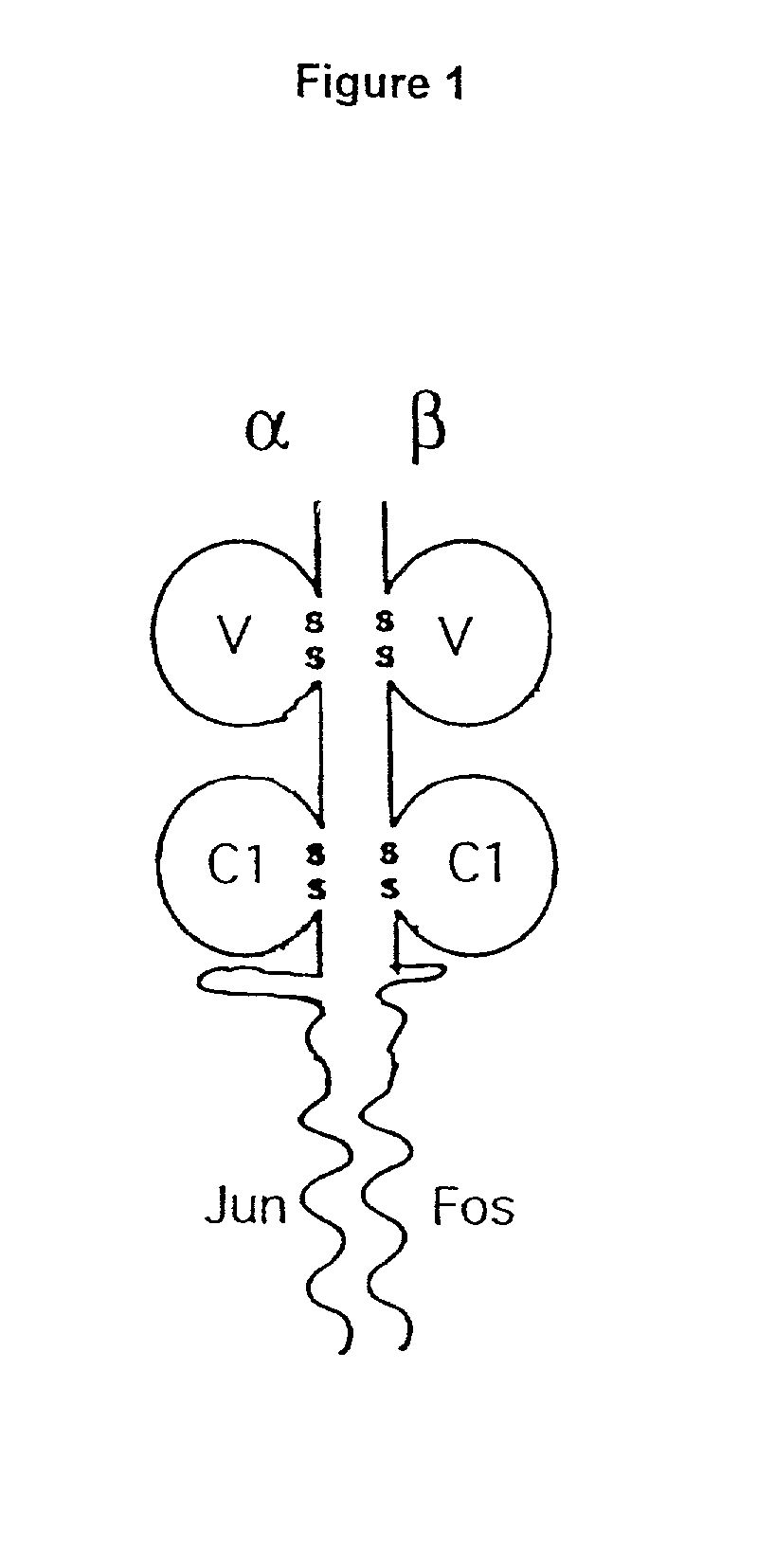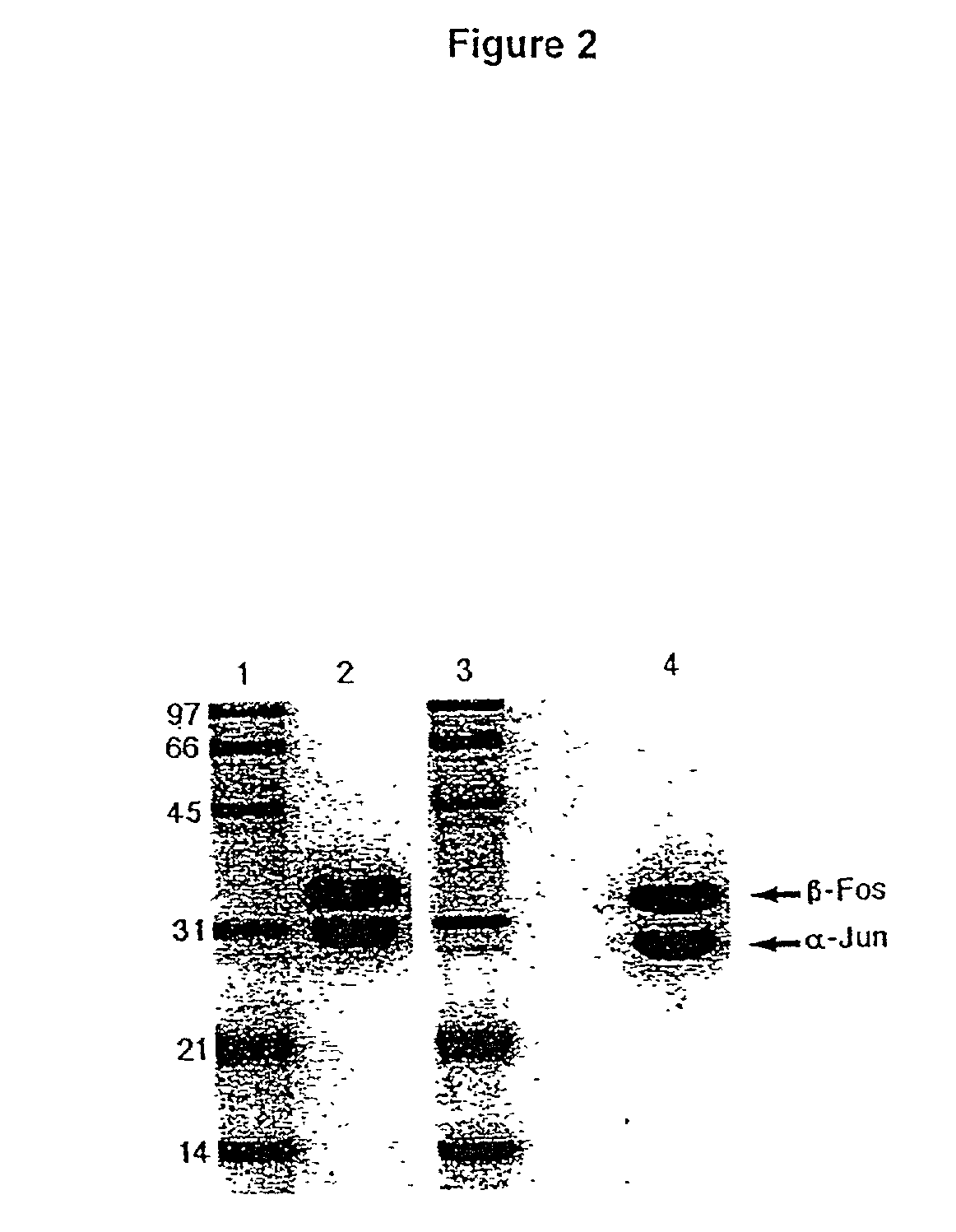Soluble T cell receptor
- Summary
- Abstract
- Description
- Claims
- Application Information
AI Technical Summary
Benefits of technology
Problems solved by technology
Method used
Image
Examples
example 1
Recombinant Soluble TCR
[0141] A recombinant soluble form of the heterodimeric TCR molecule was engineered as outlined in FIG. 1. Each chain consists of membrane-distal and -proximal immunoglobulin domains which are fused via a short flexible linker to a coiled coil motif which helps stabilise the heterodimer.
[0142] The TCR constant domains have been truncated immediately before cysteine residues which in vivo form an interchain disulphide bond. Consequently, the two chains pair by non-covalent quaternary contacts, and this is confirmed in FIG. 2b. As the Fos-Jun zipper peptide heterodimers are also capable of forming an interchain disulphide immediately N-terminal to the linker used (O'Shea et al 1989), the alignment of the two chains relative to each other was predicted to be optimal. Fusion proteins need to be joined in a manner which is compatible with each of the separate components, in order to avoid disturbing either structure.
[0143] cDNA encoding alpha and beta chains of a TC...
example 2
Kinetics and Affinity Study of Human TCR-viral Peptide-MHC
[0161] Specific Binding of Refolded TCR-zipper to Peptide-MHC Complexes
[0162] A surface plasmon resonance biosensor (Biacore) was used to analyse the binding of a TCR-zipper (JM22zip, specific for HLA-A2 influenza matrix protein M58-66 complex) to its peptide-MHC ligand (see FIG. 3). We facilitated this by producing single pMHC complexes (described below) which can be immobilised to a streptavidin-coated binding surface in a semi-oriented fashion, allowing efficient testing of the binding of a soluble T-cell receptor to up to four different pMHC (immobilised on separate flow cells) simultaneously. Manual injection of HLA complex allows the precise level of immobilised class I molecules to be manipulated easily.
[0163] Such immobilised complexes are capable of binding both T-cell receptors (see FIG. 3) and the coreceptor CD8.alpha..alpha., both of which may be injected in the soluble phase. Specific binding of TCR-zipper is obt...
example 3
Biotinylation and Tetramerisation of Soluble T-cell Receptors
[0169] 2.5 ml purified soluble TCR prepared as described in Example 1 (.about.0.2 mg / ml) was buffer exchanged into biotinylation reaction buffer (10 mM Tris pH 8.0, 5 mM NaCl, 7.5 mM MgCl.sub.2) using a PD-10 column (Pharmacia). The eluate (3.5 ml) was concentrated to 1 ml using a CENTRICON.TM. concentrator (Amicon) with a 10 kDa molecular weight cut-off. This was made up to 5 mM with ATP added from stock (0.1 g / ml adjusted to pH 7.0). A cocktail of protease inhibitors was added: leupeptin, pepstatin and PMSF (0.1 mM), followed by 1 mM biotin (added from 0.2 M stock) and 5 .mu.g / ml enzyme (from 0.5 mg / ml stock). The mixture was then incubated overnight at room temperature. Excess biotin was removed from the solution by dialysis against 10 mM Tris pH 8.0, 5 mM NaCl (200 volumes, with 2 changes at 4.degree. C.). The protein was then tested for the presence of bound biotin by blotting onto nitrocellulose followed by blocking ...
PUM
| Property | Measurement | Unit |
|---|---|---|
| Molar density | aaaaa | aaaaa |
| Molar density | aaaaa | aaaaa |
| Concentration | aaaaa | aaaaa |
Abstract
Description
Claims
Application Information
 Login to View More
Login to View More - R&D
- Intellectual Property
- Life Sciences
- Materials
- Tech Scout
- Unparalleled Data Quality
- Higher Quality Content
- 60% Fewer Hallucinations
Browse by: Latest US Patents, China's latest patents, Technical Efficacy Thesaurus, Application Domain, Technology Topic, Popular Technical Reports.
© 2025 PatSnap. All rights reserved.Legal|Privacy policy|Modern Slavery Act Transparency Statement|Sitemap|About US| Contact US: help@patsnap.com



